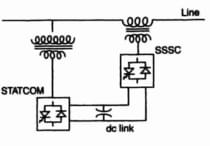 |
| Power System MCQs |
1. Series capacitive compensation on EHV transmission lines is used to________.
a. Improve the stability of the
system
b. Reduce the voltage profile
c. Improve the protection of line
d. Reduce the line loading
2. Phase modifier is normally installed in the case of_____.
a. For all length lines
b. Long length lines
c. Medium length lines
d. Short transmission line
3. For the stable operation of interconnected system, the passive
element that can be used as an interconnecting element is_______.
a. Reactor
b. Capacitor
c. Resistor
d. Any of these
4. For a synchronous phase
modifier, the load angle is______.
a. 0°
b. 30°
c. 25°
d. None of these
5. A synchronous phase modifier supplies_____.
a. Inductive reactive power only
b. Both lagging and leading
reactive power
c. Both active and reactive power
d. None of the above
6. Series capacitors on transmission line are of little use when_____.
a. The load VAR requirement is fluctuating
b. The load VAR requirement is
large
c. The load VAR requirement is small
d. None of the above
7. Full load compensator in a line requires_______.
a. Series capacitors
b. Shunt capacitors
c. Transformers
d. Shunt reactors
8. Use of additional shunt capacitor can be made for increasing the
capability of line as it________.
a. Reduces surge impedance Z0
b. Increase α
c. Increase phase shift ß
d. All of the above
9. Shunt capacitance in an EHV
line is restored to_______.
a. Improve the voltage
b. Reduce fault level
c. Improve the stability
d. None of the above
10. For a synchronous generator connected to a
power station, increase in excitation will_______.
a. Increase active power
generation
b. Decrease active power
generation
c. Increase reactive power generation
d. Decrease reactive power generation
11. A power system needs
injection of VARs at_______.
a. Full load
b. Both peak and off-peak load
c. Peak load
d. off-peak load
12. Shunt capacitors in a
substation_____.
a. Deliver active power
b. Consume active power
c. Deliver lagging VARs
d. Consume lagging VARs
13. During load shedding______.
a. System power factor is
changed
b. System loads are switched off
c. System frequency is reduced
d. System voltage is reduced
14. Flow of active power
through a line in a power system may be controlled by______.
a. Synchronous phase modifier
b. Phase shifting transformer
c. Tap changing transformer
d. Any of the above
15. Which of the following is
not a sub-component of load-frequency controller?
a. Hydraulic amplifier
b. Exciter
c. Linkage mechanism
d. Speed changer
16. Whenever there is a change in
frequency of the system due to a change in the load demand, the component of the
load frequency controller which senses this change in load is______.
a. Speed governer
b. Linkage mechanism
c. Hydraulic amplifier
d. Speed changer
17. When the speed governer
fails to sense any variation/change in the load demand, the resulting load
frequency control is termed as______.
a. Free governer operation
b. Integral controller
operation
c. Proportional controller
operation
d. None of the above







0 Comments
If you have any doubt, feel free to ask.